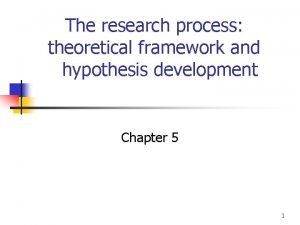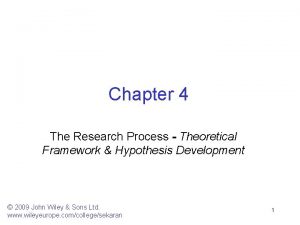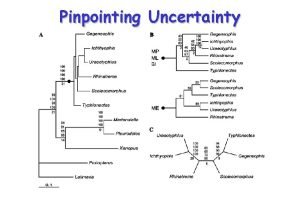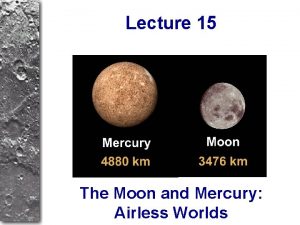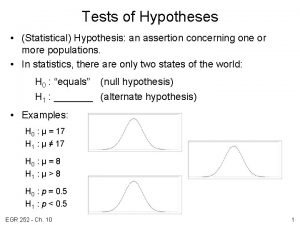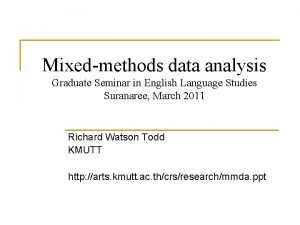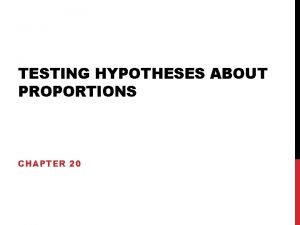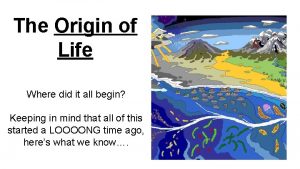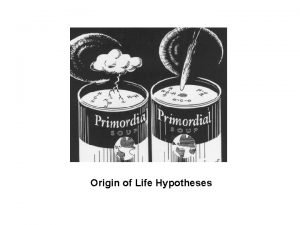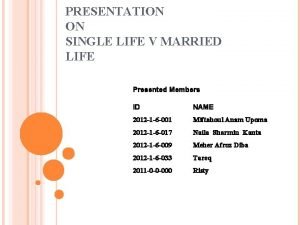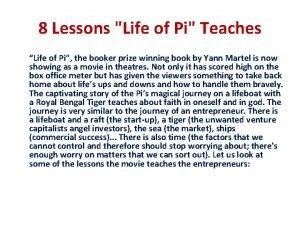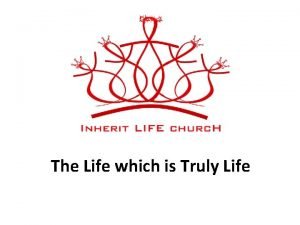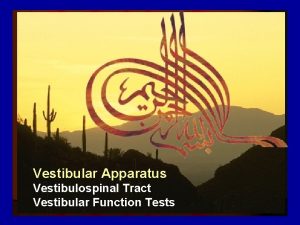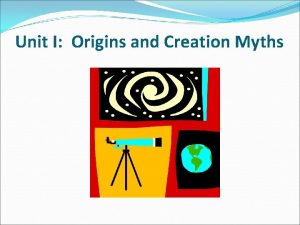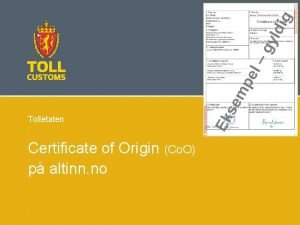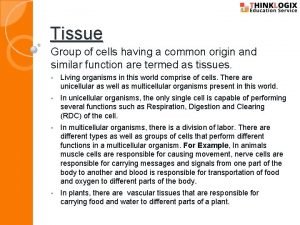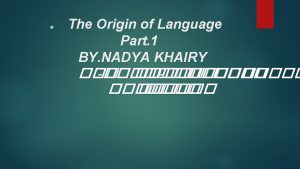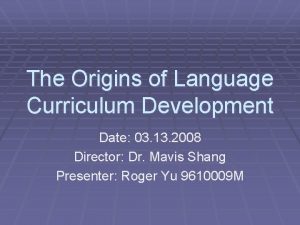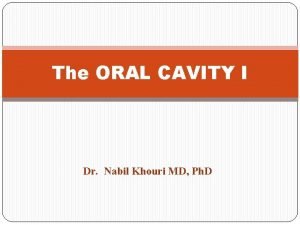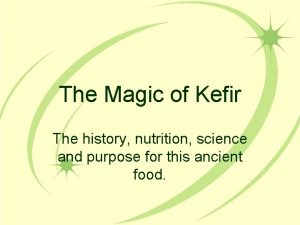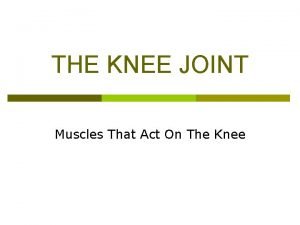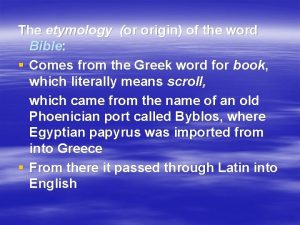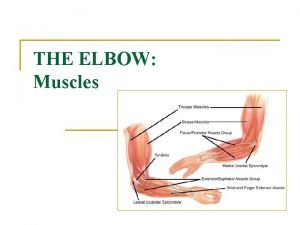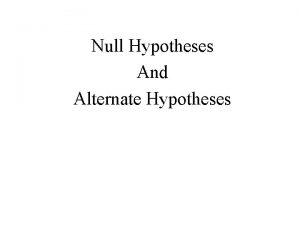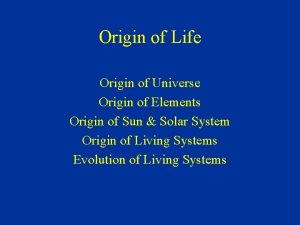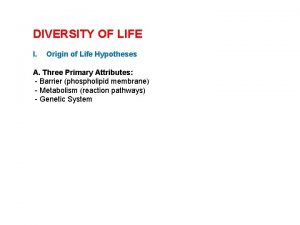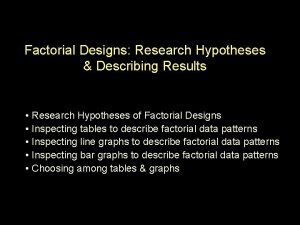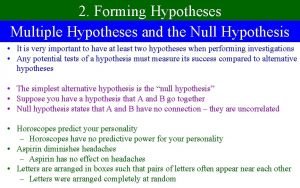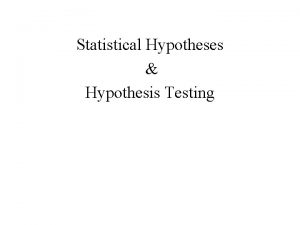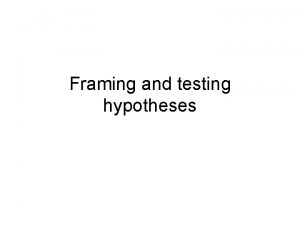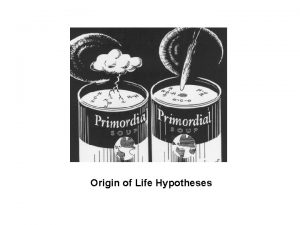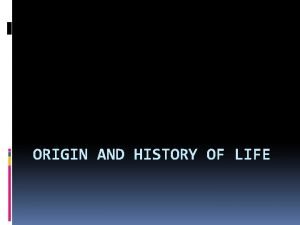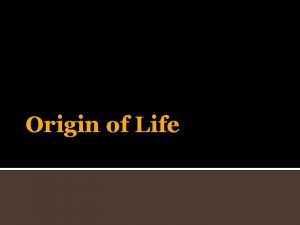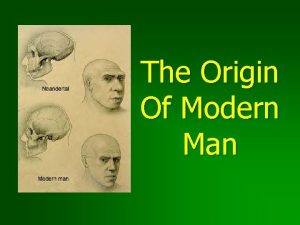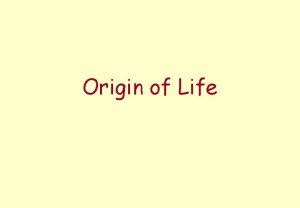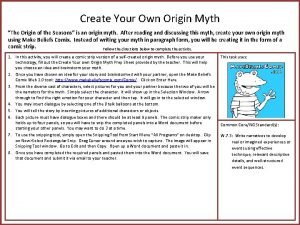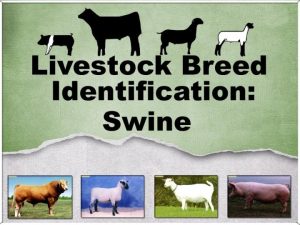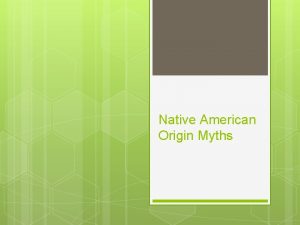Origin of Life Hypotheses Origin of Life Hypotheses























































- Slides: 55

Origin of Life Hypotheses

Origin of Life Hypotheses Origin of life hypotheses Evolutionary Theory

4. 5 bya: Earth Forms A. The Early Earth and Earth History Graviational sorting of materials…heavy to the core, gases released under pressure…

A. The Early Earth and Earth History - Earliest Atmosphere - probably of volcanic origin Gases produced were probably similar to those released by modern volcanoes (H 2 O, CO 2, SO 2, CO, S 2, Cl 2, N 2, H 2) and NH 3 and CH 4

4. 0 bya: Oldest Rocks 4. 5 bya: Earth Forms A. The Early Earth and Earth History

4. 0 bya: Oldest Rocks 3. 4 bya: Oldest Fossils 4. 5 bya: Earth Forms A. The Early Earth and Earth History Stromatolites - communities of layered 'bacteria'

4. 0 bya: Oldest Rocks 3. 4 bya: Oldest Fossils 4. 5 bya: Earth Forms A. The Early Earth and Earth History Putative microfossil bacteria from Australia that date to 3. 4 by

- the first cells were probably heterotrophs that simply absorbed nutrients and ATP from the environment. - as these substances became rare, there was strong selection for cells that could manufacture their own energy storage molecules. - the most primitive cells are methanogens (Archaea), but these are NOT the oldest fossils.

- the second type of cells were probably like green-sulphur bacteria, which used H 2 S as an electron donor, in the presence of sunlight, to photosynthesize.

IV. Early Life - about 3. 2 bya, “banded iron” formations occur… these are formed by the oxidation of dissolved iron and Sulphur … removal of electrons by primitive ‘non-oxygenic’ photosynthesis, resulting in rusty precipitates of iron.

2. 3 -2. 0 bya: Oxygen in Atmosphere 4. 0 bya: Oldest Rocks 3. 4 bya: Oldest Fossils 4. 5 bya: Earth Forms A. The Early Earth and Earth History “Red Beds”

- the evolution of oxygenic photosynthesis was MAJOR. It allowed life to exploit more habitats, and it produced a powerful oxidating agent!

1. 8 bya: first eukaryote 2. 3 -2. 0 bya: Oxygen 4. 0 bya: Oldest Rocks 3. 4 bya: Oldest Fossils 4. 5 bya: Earth Forms A. The Early Earth and Earth History


Eukaryote Characteristics - membrane bound nucleus - organelles - sexual reproduction

0. 9 bya: first animals 1. 8 bya: first eukaryote 2. 3 -2. 0 bya: Oxygen 4. 0 bya: Oldest Rocks 3. 4 bya: Oldest Fossils 4. 5 bya: Earth Forms A. The Early Earth and Earth History

0. 5 bya: Cambrian 0. 9 bya: first animals 1. 8 bya: first eukaryote 2. 3 -2. 0 bya: Oxygen 4. 0 bya: Oldest Rocks 3. 4 bya: Oldest Fossils 4. 5 bya: Earth Forms A. The Early Earth and Earth History

0. 5 bya: Cambrian 0. 24 bya: Mesozoic 0. 9 bya: first animals 1. 8 bya: first eukaryote 2. 3 -2. 0 bya: Oxygen 4. 0 bya: Oldest Rocks 3. 4 bya: Oldest Fossils 4. 5 bya: Earth Forms A. The Early Earth and Earth History

0. 5 bya: Cambrian 0. 24 bya: Mesozoic 0. 065 bya: Cenozoic 0. 9 bya: first animals 1. 8 bya: first eukaryote 2. 3 -2. 0 bya: Oxygen 4. 0 bya: Oldest Rocks 3. 4 bya: Oldest Fossils 4. 5 bya: Earth Forms A. The Early Earth and Earth History

0. 5 bya: Cambrian 0. 24 bya: Mesozoic 0. 065 bya: Cenozoic 0. 9 bya: first animals 1. 8 bya: first eukaryote 2. 3 -2. 0 bya: Oxygen 4. 0 bya: Oldest Rocks 3. 4 bya: Oldest Fossils 4. 5 bya: Earth Forms A. The Early Earth and Earth History 4. 5 million to present (1/1000 th of earth history)

B. The Formation of Biologically Important Molecules - Oparin-Haldane Hypothesis (1924): - in a reducing atmosphere, biomonomers would form spontaneously Aleksandr Oparin (1894 -1980) J. B. S. Haldane (1892 -1964)

B. The Formation of Biologically Important Molecules - Oparin-Haldane Hypothesis (1924): - in a reducing atmosphere, biomonomers would form spontaneously - Miller-Urey (1953) all biologically important monomers have been produced by these experiments, even while changing gas composition and energy sources

B. The Formation of Biologically Important Molecules - Oparin-Haldane Hypothesis (1924): - in a reducing atmosphere, biomonomers would form spontaneously - Miller-Urey (1953) - Sydney Fox - 1970 - polymerized protein microspheres

B. The Formation of Biologically Important Molecules - Oparin-Haldane Hypothesis (1924): - in a reducing atmosphere, biomonomers would form spontaneously - Miller-Urey (1953) - Sydney Fox - 1970 - polymerized protein microspheres - Cairns-Smith (1960 -70) - clays as templates for non-random polymerization - 1969 - Murcheson meteorite - amino acids present; some not found on Earth. To date, 74 meteoric AA's. - 2004 - Szostak - clays could catalyze formation of RNA's

C. Acquiring the Characteristics of Life Three Primary Attributes: - Barrier (phospholipid membrane) - Metabolism (reaction pathways) - Genetic System

C. Acquiring the Characteristics of Life 1. Evolution of a Membrane - form spontaneously in aqueous solutions

C. Acquiring the Characteristics of Life 1. Evolution of a Membrane 2. Metabolic Pathways - problem: how can pathways with useless intermediates evolve? These represent 'maladaptive valleys', don't they? A B C D How do you get from A to E, if B, C, and D are non-functional? E

C. Acquiring the Characteristics of Life 1. Evolution of a Membrane 2. Metabolic Pathways - Solution - reverse evolution A B C D E

C. Acquiring the Characteristics of Life 1. Evolution of a Membrane 2. Metabolic Pathways - Solution - reverse evolution suppose E is a useful molecule, initially available in the env. E

C. Acquiring the Characteristics of Life 1. Evolution of a Membrane 2. Metabolic Pathways - Solution - reverse evolution suppose E is a useful molecule, initially available in the env. As protocells gobble it up, the concentration drops. E

C. Acquiring the Characteristics of Life 1. Evolution of a Membrane 2. Metabolic Pathways - Solution - reverse evolution D Anything that can absorb something else (D) and MAKE E is at a selective advantage. . . E

C. Acquiring the Characteristics of Life 1. Evolution of a Membrane 2. Metabolic Pathways - Solution - reverse evolution D Anything that can absorb something else (D) and MAKE E is at a selective advantage. . . but over time, D may drop in concentration. . . E

C. Acquiring the Characteristics of Life 1. Evolution of a Membrane 2. Metabolic Pathways - Solution - reverse evolution C D So, anything that can absorb C and then make D and E will be selected for. . . E

C. Acquiring the Characteristics of Life 1. Evolution of a Membrane 2. Metabolic Pathways - Solution - reverse evolution A B C D and so on until a complete pathway evolves. E

C. Acquiring the Characteristics of Life 1. Evolution of a Membrane 2. Metabolic Pathways 3. Evolution of a Genetic System - conundrum. . . which came first, DNA or the proteins they encode? DNA RNA (m, r, t) protein

C. Acquiring the Characteristics of Life 1. Evolution of a Membrane 2. Metabolic Pathways 3. Evolution of a Genetic System - conundrum. . . which came first, DNA or the proteins they encode? DNA stores info, but proteins are the metabolic catalysts. . . RNA (m, r, t) protein

C. Acquiring the Characteristics of Life 1. Evolution of a Membrane 2. Metabolic Pathways 3. Evolution of a Genetic System - conundrum. . . which came first, DNA or the proteins they encode? - Ribozymes info storage AND cataylic ability

C. Acquiring the Characteristics of Life 1. Evolution of a Membrane 2. Metabolic Pathways 3. Evolution of a Genetic System - conundrum. . . which came first, DNA or the proteins they encode? - Ribozymes - Self replicating molecules - three stage hypothesis

Stage 1: Self-replicating RNA evolves RNA

Stage 1: Self-replicating RNA evolves RNA m- , r- , and t- RNA PROTEINS (REPLICATION ENZYMES) Stage 2: RNA molecules interact to produce proteins. . . if these proteins assist replication (enzymes), then THIS RNA will have a selective (replication/reproductive) advantage. . . chemical selection.

DNA Reverse transcriptases m- , r- , and t- RNA PROTEINS (REPLICATION ENZYMES) Stage 3: Mutations create new proteins that read RNA and make DNA; existing replication enzymes replicate the DNA and transcribe RNA.

Can this happen? Are their organisms that read RNA and make DNA?

Can this happen? Are their organisms that read RNA and make DNA? yes - retroviruses. .


DNA m- , r- , and t- RNA Already have enzymes that can make RNA. . . PROTEINS (REPLICATION ENZYMES) Stage 3: Mutations create new proteins that read RNA and make DNA; existing replication enzymes replicate the DNA and transcribe RNA.

DNA m- , r- , and t- RNA Already have enzymes that can make RNA. . . PROTEINS (REPLICATION ENZYMES) Stage 3: Mutations create new proteins that read RNA and make DNA; existing replication enzymes replicate the DNA and transcribe RNA.

DNA This is adaptive because the two-step process is more productive, and DNA is more stable (less prone to mutation). m- , r- , and t- RNA PROTEINS (REPLICATION ENZYMES) Stage 4: Mutations create new proteins that replicate the DNA instead of replicating the RNA. . .

DNA m- , r- , and t- RNA This is adaptive because the two-step process is more productive, and DNA is more stable (less prone to mutation). And that's the system we have today. . PROTEINS (REPLICATION ENZYMES) Stage 4: Mutations create new proteins that replicate the DNA instead of replicating the RNA. . .

D. Summary: STEPS REQUIRED FOR THE SPONTANEOUS, NATURAL FORMATION OF LIFE, and the evidence to date: 1. Spontaneous synthesis of biomolecules - strong evidence; Miller. Urey experiments. 2. Polymerization of monomers into polymers (proteins, RNA, sugars, fats, etc. ) - strong evidence; Fox and Cairns-Smith experiments. 3. Formation of membranes - strong evidence; behavior of phospholipids in solution. 4. Evolution of metabolic systems - reasonable hypotheses, and genetic similarity in genes involved in particular pathways (suggesting gene duplication and subsequent evolution of new genes and elaboration of existing pathways) 5. Evolution of a genetic system - a reasonable hypothesis and significant corroborating evidence that it could happen. But no experimental evidence of the process evolving through all three steps. 6. How did these three elements (membrane, metabolism, genetic system come together? ) a few untested hypotheses.

IV. Early Life Woese - r-RNA analyses reveal a deep divide within the bacteria

IV. Early Life

IV. Early Life

IV. Early Life Curiously, the very root of life may be invisible to genetic analysis. Bacteria transfer genes by division (to 'offspring'), but they also transfer genes "laterally" to other living bacteria. This makes reconstructing bacterial phylogenies difficult.

IV. Early Life So, reconstructing the patterns of relatedness among these ancient life forms is difficult. Different genes give different patterns of relatedness among domains

IV. Early Life C. Domains - "Ring of Life" hypothesis (2004)
 Hypotheses development
Hypotheses development Hypotheses in research example
Hypotheses in research example Framework hypothesis
Framework hypothesis Chapter 20 testing hypotheses about proportions
Chapter 20 testing hypotheses about proportions Theoretical framework for business research
Theoretical framework for business research Ruling out rival hypotheses
Ruling out rival hypotheses Analysis of competing hypotheses template
Analysis of competing hypotheses template Two types of hypothesis
Two types of hypothesis Explain general to specific ordering of hypothesis
Explain general to specific ordering of hypothesis Chapter 19 testing hypotheses about proportions
Chapter 19 testing hypotheses about proportions Marzano high yield instructional strategies
Marzano high yield instructional strategies Hypotheses
Hypotheses Hypothesis in statistics
Hypothesis in statistics Hypothesis in research
Hypothesis in research Examples of quantitative research questions and hypotheses
Examples of quantitative research questions and hypotheses Chapter 20 testing hypotheses about proportions
Chapter 20 testing hypotheses about proportions Origin of life
Origin of life Oparin
Oparin When life gives you lemons origin
When life gives you lemons origin City life and country life paragraph
City life and country life paragraph Farm life vs city life
Farm life vs city life Applications of polynomials in daily life
Applications of polynomials in daily life Single life or married life which is better
Single life or married life which is better Life orientation skills
Life orientation skills Country life vs city life compare /contrast
Country life vs city life compare /contrast City life vs country life
City life vs country life Lessons in life of pi
Lessons in life of pi Boundaries meme
Boundaries meme Life that is truly life
Life that is truly life The idea life comes from life is
The idea life comes from life is Freetutorical.com harvest land
Freetutorical.com harvest land Daoism founder
Daoism founder The witches of easter-wick in finland
The witches of easter-wick in finland Same origin policy example
Same origin policy example Vestibular
Vestibular Kinocillium
Kinocillium Peripheral vertigo
Peripheral vertigo Origin myths definition
Origin myths definition Tower of hanoi origin
Tower of hanoi origin Certificate of origin
Certificate of origin Protective tissue
Protective tissue Divine source origin of language
Divine source origin of language The rolling stones origin
The rolling stones origin History of curriculum
History of curriculum Easter origin
Easter origin The origin of species ch 24
The origin of species ch 24 Santa claus origin
Santa claus origin Tonofilaments
Tonofilaments Magic of kefir
Magic of kefir Semitendinosus muscle
Semitendinosus muscle The origin of pop music
The origin of pop music As i sat there brooding on the old
As i sat there brooding on the old Origin of the word bible
Origin of the word bible Brachialis actions
Brachialis actions Korea
Korea Protraction of scapula
Protraction of scapula
